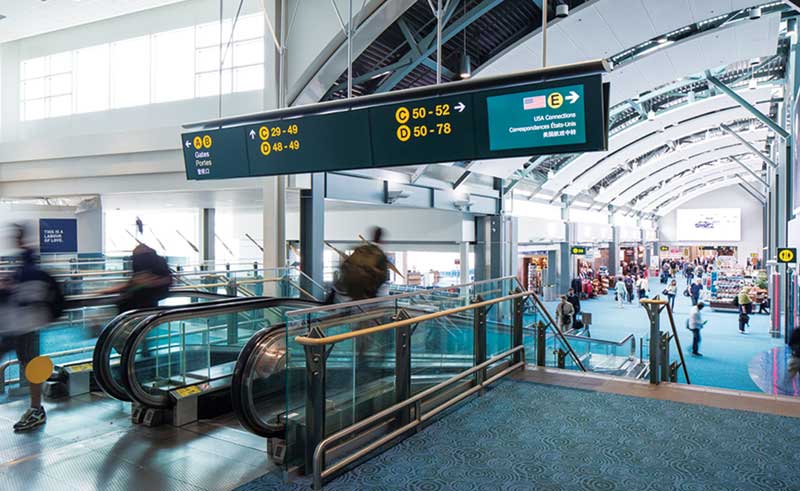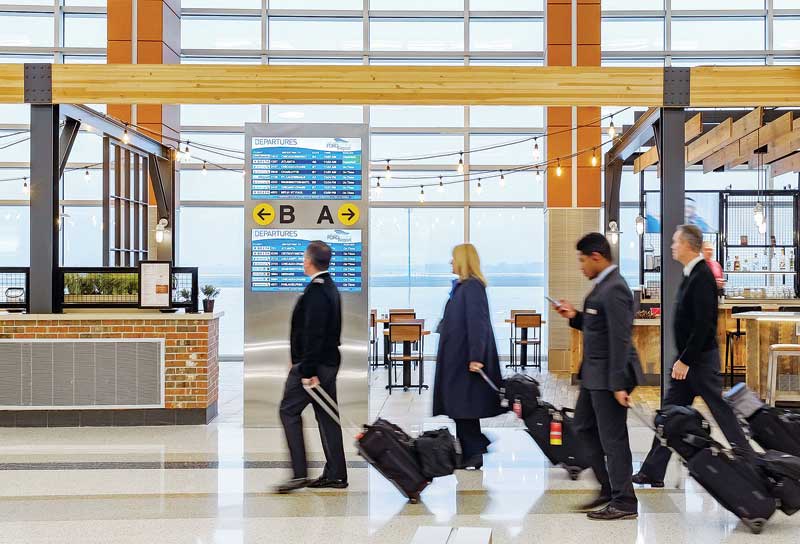Wayfinding: Designing for tomorrow’s airports
by all | 24 May 2018 10:00 am
 [1]
[1]Photos courtesy Entro
By Angela Carter
The ways in which passengers use and interact with airports is changing. These large-scale facilities are no longer simply a place to catch a flight; they are increasingly becoming a destination unto themselves, a locale where individuals enjoy spending their time, by offering everything from retail to dining to entertainment in one place.
As airport planning evolves and is no longer solely focused on air travel, there are effects that relate to wayfinding, i.e. how individuals orient themselves in the physical space and navigate from place to place. Sign design needs to acknowledge the shifts affecting today’s airports and the role these facilities will play in the future.
A changing setting
In a broad context, multi-use space is at the forefront of many building developments. For airports in particular, both large and small, there has been a cultural shift to focus on the principles of the hospitality industry, which in turn is influencing their design.
As destinations intended to meet all of a traveller’s needs, after all, airports have added more options for shopping, dining, entertainment, fitness, relaxation and accommodation. And for an airport’s operators, these amenities contribute to greater potential revenue generation.
Another key factor that drives change in airports is a focus on efficiency. With advances in technology, operators seek to hone their methods for improving the overall travel experience.
Technological developments
To some degree, airports have led the way in providing a common experience to users no matter where they are. Airports around the world appear relatively similar—and thus comfortingly familiar—to visitors. Similarly, future applications of wayfinding technology in airports are likely to embrace universality, which could affect the design and role of physical signs.
There will always be individuals, after all, who do not use mobile devices in an airport. Their wayfinding experience must be taken into account. Physical signage is essential for the utility and function of the space, since it applies to all types of users.
Changes in industrial design will also have an effect on signage and displays. These may include new lighting technologies, alternative methods for applying graphics, refinements to materials (such as aluminum and acrylic) and thinner, smaller digital signage displays, among others.
With the rise of the Internet of Things (IoT), physical wayfinding signs could also be encoded with digital capabilities.
Large-scale digital signage displays are already a common sight in airports, of course, because they can provide real-time information, based on flight data tracking, weather conditions and other contextual content. When they are placed in appropriate locations with maximum visibility, they help offer peace of mind to travellers and reduce their anxiety.
 [2]
[2]As airports around the world introduce amenities to generate additional revenues, new signs are needed to lead passengers to those areas.
The passenger journey
Given the evolution of airports, the sequence of events for a passenger’s journey is likely to change. Security screening, for example, could be done immediately upon entry to the airport, rather than after checking in and dropping off bags. The process could be streamlined for all user groups, including passengers, non-travelling visitors and staff members.
Some airports have already rejigged their baggage handling systems to allow for remote drop-offs, which directly affects how and when a passenger checks in. Similarly, the increased presence of ‘swing conditions’ (i.e. flexible-use spaces) for multiple functions will affect when, where and how passengers form queues for flights.
Given these changes, digital signs could be leveraged for their versatility, familiarity for users and future affordability. These displays can play a central role in wayfinding as part of a cohesive system.
By being involved in the early stages of a project, signage consultants are better-positioned to provide an overarching wayfinding strategy. When a major expansion was planned at Calgary International Airport, for example, early involvement helped influence a logical and effective ordering and naming scheme for 24 new gates and two new concourses, setting the stage for more intuitive navigation.
 [3]
[3]When digital displays are placed in appropriate locations with maximum visibility for flight information, they can help offer peace of mind to travellers.
Airport as destination
With the proliferation of air travel, airports have become bigger, a trend that is likely to continue in the future. Like many large cities’ central train stations, they could become cultural and social destinations in their own right.
Indeed, many airports are becoming multimodal hubs, where flying is just one of many types of transportation, from taxis and shuttles to buses and trains. And as these forms of transportation become more readily available, parking lots will become less necessary and, in turn, occupy less space. The same space could be repurposed for other means.
In this sense, airports are somewhat like cities unto themselves, with the surrounding infrastructure synthesizing into a larger, interconnected system, while the core elements can evolve to meet changing needs.
Airports also feel more like destinations unto themselves when they create a true sense of place. There are numerous means for such placemaking, from the colourful pictographics of Germany’s Cologne Bonn Airport to the central waterfall feature of Singapore’s Changi Airport to local artists’ installations at Calgary International Airport.
Providing a seamless experience is the basic precept of ‘integrated mobility,’ which is the common goal for most future-focused transportation services. Through early planning, rigorous consideration and analysis of pedestrian traffic flow and a willingness to adapt signage to anticipate and accommodate users’ needs, it is possible to tailor airport wayfinding to everyone’s benefit.
Angela Carter is a designer for Entro, a Toronto-based environmental graphic design (EGD) firm that develops wayfinding sign systems for airports and other facilities. For more information, visit www.entro.com[4].
- [Image]: https://www.signmedia.ca/wp-content/uploads/2018/05/airport9.jpg
- [Image]: https://www.signmedia.ca/wp-content/uploads/2018/05/airport11.jpg
- [Image]: https://www.signmedia.ca/wp-content/uploads/2018/05/airport_geraldford1.jpg
- www.entro.com: http://www.entro.com
Source URL: https://www.signmedia.ca/wayfinding-designing-for-tomorrows-airports/